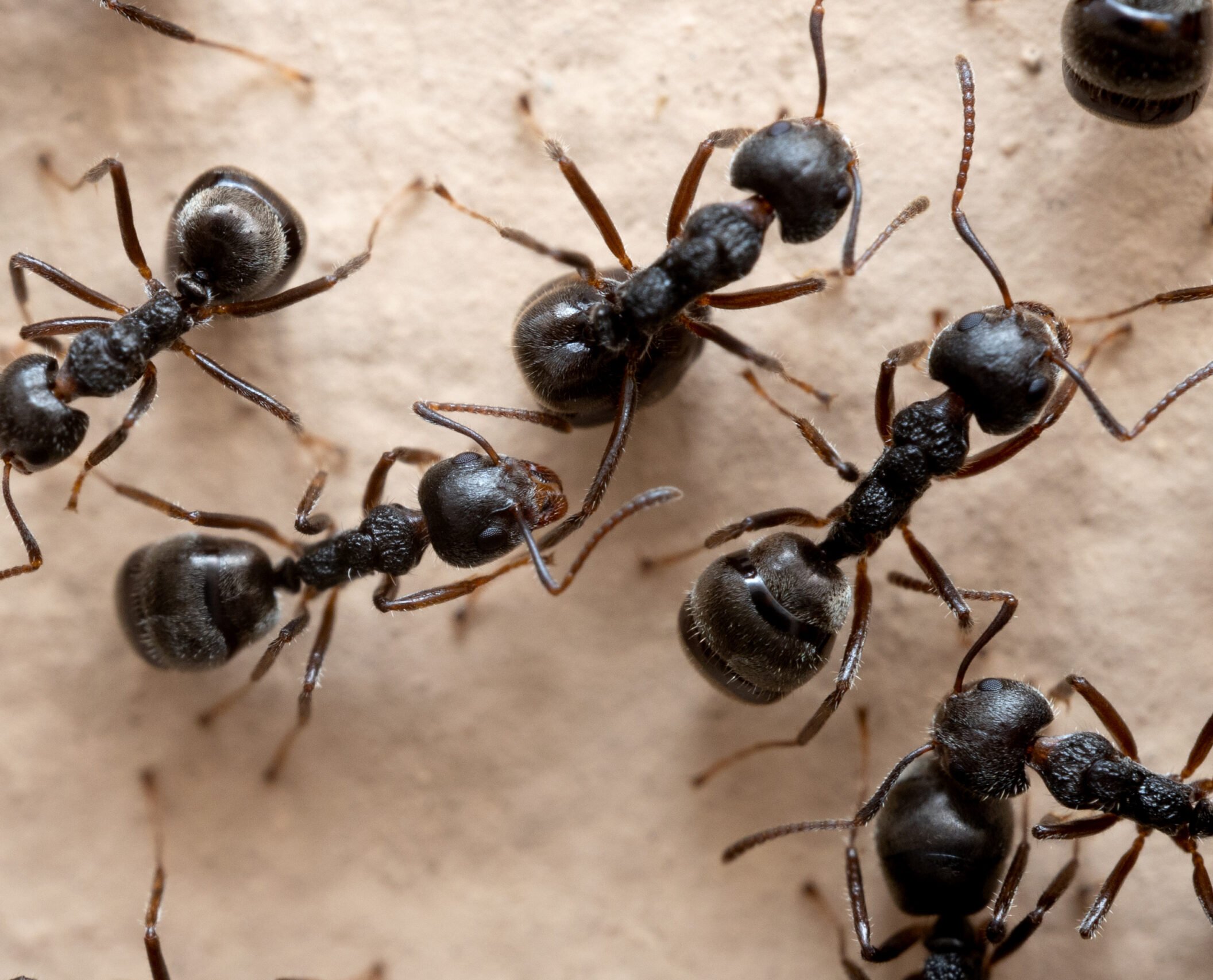



Trying to list them all would be impossible. 🙂
Below are the most common and abundant types of ants, which are part of the insect family Formicidae.
You can find them in grasslands, deciduous forests, and urban and suburban areas. As their name suggests, they prefer to build their nests in wood, often using decaying logs, deciduous trees, or wood structures.
Eastern Black Carpenter Ants aren’t picky eaters and feed on other insects, trash, nectar, fruit, and fungi.
These ants are surprisingly long-lived! While reproductive males usually die shortly after mating, workers may live for seven or more years. Queens can live for over ten years.


The American Winter Ant earned its name for its unique ability to move about and forage in temperatures that send other ants into their nests for shelter. When other ants are foraging in the summer, they usually seal themselves into their nests and enter a hibernation-like state.
They may seem insignificant, but these insects are essential to our forests. Many native wildflowers like bloodroot, trillium, and violets depend on this ant for survival. The plants have a calorie-dense appendage attached to each seed, encouraging the ants to harvest and transport them to a new location.
This is partially because of their ability to forage at cool temperatures and their defensive capabilities. They are aggressive with other ants and produce abdominal secretions that are lethal to many other ant species, including the invasive Argentine ant (Linepithema humile).
Immigrant Pavement Ants thrive in urban areas of Vermont. These European natives like building underground nests in areas with little vegetation. Consequently, you’ll often see them nesting near sidewalks, patios, foundations, and pavement.
Each of about 1000 ants defends a territory of around 460 square feet (43 m2). It’s common to see colonies battling for territory boundaries, especially in spring, as new colonies are established. The workers also forage for honeydew excreted by aphids, seeds, insects, fruit, and human food like bread and cheese.
Gardeners may be happy to see immigrant pavement ants around their property since they are significant predators of coddling moth larvae, a major agricultural pest in North America.


Odorous house ants are incredibly widespread because they can adapt to nearly any habitat in North America. They tolerate various habitats from sea level to 13,000 feet (4000 m) of elevation and occupy urban areas, forests, grasslands, bogs, and sandy coastal areas.
And they aren’t just searching for a comfortable place to live; odorous house ants love sweets! In the wild, they tend to feed on aphid honeydew and flower nectar, but they will gladly take advantage of human food when available.
They often nest outside on stumps, rocks, matted grass, and other debris but use cracks and termite-damaged wood found in homes. Interestingly, these nests aren’t stationary.
Odorous house ants tend to move their nests about every 21 days. They also tend to coexist peacefully with other ant species rather than strictly defend a territory.
Common Citronella Cnts look and smell like the Larger Citronella Ant (Lasius interjectus), another ant species in Vermont. Their only real variation is their slight size difference. Larger Aitronella Ants may reach 0.2 inches (4.5 mm) long.
Interestingly, these ants don’t usually build nests themselves. The queens infiltrate the nest of a different ant species, kill the queen, and use the workers to care for the initial brood of eggs. This takes an enormous burden off the queen and gives the colony a jump start. Because of this “shortcut,” colonies can quickly become enormous and spread over large sections of forest.
You can find colonies of Common Citronella Ants in gardens, lawns, open woodlands, pastures, and near house foundations. The nests are often positioned under an object like a stone, log, or stump for cover.


New York carpenter ants may be the fastest-growing ant species in Vermont! They occur in moist woodlands, on the edges of bogs, and in wetlands. As their name suggests, they prefer to build their nests in wood. Usually, they create tunnels in stumps, logs, or old houses.
While they don’t eat wood, only tunnel and nest in it, they have voracious appetites! New York carpenter ants will feed on almost anything they find, including carrion, beetle larvae, honeydew, flower nectar, human scraps, and other insects like roaches and fruit flies.
Watch the video below to see them collect honeydew from aphids!




These impressive mounds of soil can reach 3-9 ft (0.9-2.7 m) in diameter and about 2 ft (0.6 m) tall, though some historical records indicate even larger mounds.
These mounds serve primarily as protection for the queens and an incubating chamber for eggs and larvae. They have tunnels that may also extend about four feet into the ground.
Allegheny mound ants show a strong preference for open, sunny habitats. They tend to nest on strip mines and ridge tops. They also work hard to keep their territory open and free of brush or other plants.
These ants inject formic acid into trees and shrubs, killing any vegetation within 40-50 ft (12-15 m) of their mounds.
They sometimes form supercolonies in ideal habitats with interconnected mounds spread over a fairly large territory. These supercolonies can contain millions of ants and may persist for decades!
Check out these ID guides focusing specifically on different insects and arachnids in Vermont.
If so, check out this excellent ID guide!
Leave a comment below!